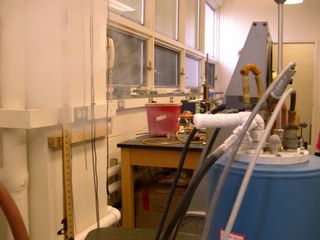99% Hell, 1% Working Experiment
This is easily the nerdiest post I've ever made, and I'm amazed that I'm even doing this. But, I am. I am posting about my physics lab, because damnit, I worked for so long on this. And I am beside myself now that it finally worked.
Our experiment was to observe the 2D Quantum Hall Effect. To keep it simple, in the presence of high magnetic fields, and at very low temperatures (~ 4 Kelvin), you can see the quantization of resistance. It's very neat. Lots of expensive, dangerous, and tall equipment.
But as interesting as the experiment sounded on paper, it was a nightmare in practice. For the past 5 weeks of the semester, my lab partner and I have been banging our heads against a brick wall trying to get our experiment to work. True, the majority of physics labs consists of just that--but this one was particularly more painful. The combination of a completely fried diode inside of our magnet, a magnet power supply controler that refused to communicate with us, general stupidity, etc., meant 9 4-hour lab periods of sheer frustration and one rushed "IT WORKS! IT WORKS! TAKE DATA NOW!" lab period.
Now that we have actual data and I understand the general theory behind everything, I have to say that the experiment is pretty amazing. It almost makes up for the last 5 weeks. Of course, I can't complain too much. I did get to play with liquid helium for much of the time.
A few pictures of super-coldness:

The white cloud is the helium vaporizing as it hits the warm air.

The ice building up around our equipment as we fill it with the liquid helium.

A closer picture. If you look closely, you can see liquid oxygen forming on the pipe as the air around it liquifies.
And I must admit, this plot makes me very happy:

 Sorry for the poor quality. Photoshop was not cooperating with me.
Sorry for the poor quality. Photoshop was not cooperating with me.
Anyways. There it is! Quantized resistance! Hooray! Sure, we don't get quite the right value for the ratio we were supposed to measure, but at this point even an order of magnitude match is thrilling.
I won't do this again, I promise.
Our experiment was to observe the 2D Quantum Hall Effect. To keep it simple, in the presence of high magnetic fields, and at very low temperatures (~ 4 Kelvin), you can see the quantization of resistance. It's very neat. Lots of expensive, dangerous, and tall equipment.
But as interesting as the experiment sounded on paper, it was a nightmare in practice. For the past 5 weeks of the semester, my lab partner and I have been banging our heads against a brick wall trying to get our experiment to work. True, the majority of physics labs consists of just that--but this one was particularly more painful. The combination of a completely fried diode inside of our magnet, a magnet power supply controler that refused to communicate with us, general stupidity, etc., meant 9 4-hour lab periods of sheer frustration and one rushed "IT WORKS! IT WORKS! TAKE DATA NOW!" lab period.
Now that we have actual data and I understand the general theory behind everything, I have to say that the experiment is pretty amazing. It almost makes up for the last 5 weeks. Of course, I can't complain too much. I did get to play with liquid helium for much of the time.
A few pictures of super-coldness:

The white cloud is the helium vaporizing as it hits the warm air.

The ice building up around our equipment as we fill it with the liquid helium.

A closer picture. If you look closely, you can see liquid oxygen forming on the pipe as the air around it liquifies.
And I must admit, this plot makes me very happy:

 Sorry for the poor quality. Photoshop was not cooperating with me.
Sorry for the poor quality. Photoshop was not cooperating with me.Anyways. There it is! Quantized resistance! Hooray! Sure, we don't get quite the right value for the ratio we were supposed to measure, but at this point even an order of magnitude match is thrilling.
I won't do this again, I promise.


